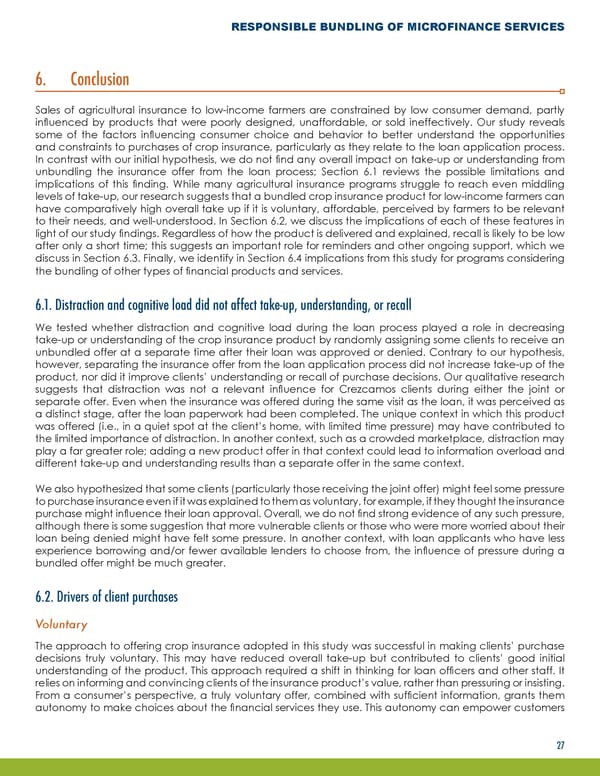RESPONSIBLE BUNDLING OF MICROFINANCE SERVICES 6. Conclusion Sales of agricultural insurance to low-income farmers are constrained by low consumer demand, partly influenced by products that were poorly designed, unaffordable, or sold ineffectively. Our study reveals some of the factors influencing consumer choice and behavior to better understand the opportunities and constraints to purchases of crop insurance, particularly as they relate to the loan application process. In contrast with our initial hypothesis, we do not find any overall impact on take-up or understanding from unbundling the insurance offer from the loan process; Section 6.1 reviews the possible limitations and implications of this finding. While many agricultural insurance programs struggle to reach even middling levels of take-up, our research suggests that a bundled crop insurance product for low-income farmers can have comparatively high overall take up if it is voluntary, affordable, perceived by farmers to be relevant to their needs, and well-understood. In Section 6.2, we discuss the implications of each of these features in light of our study findings. Regardless of how the product is delivered and explained, recall is likely to be low after only a short time; this suggests an important role for reminders and other ongoing support, which we discuss in Section 6.3. Finally, we identify in Section 6.4 implications from this study for programs considering the bundling of other types of financial products and services. 6.1. Distraction and cognitive load did not affect take-up, understanding, or recall We tested whether distraction and cognitive load during the loan process played a role in decreasing take-up or understanding of the crop insurance product by randomly assigning some clients to receive an unbundled offer at a separate time after their loan was approved or denied. Contrary to our hypothesis, however, separating the insurance offer from the loan application process did not increase take-up of the product, nor did it improve clients’ understanding or recall of purchase decisions. Our qualitative research suggests that distraction was not a relevant influence for Crezcamos clients during either the joint or separate offer. Even when the insurance was offered during the same visit as the loan, it was perceived as a distinct stage, after the loan paperwork had been completed. The unique context in which this product was offered (i.e., in a quiet spot at the client’s home, with limited time pressure) may have contributed to the limited importance of distraction. In another context, such as a crowded marketplace, distraction may play a far greater role; adding a new product offer in that context could lead to information overload and different take-up and understanding results than a separate offer in the same context. We also hypothesized that some clients (particularly those receiving the joint offer) might feel some pressure to purchase insurance even if it was explained to them as voluntary, for example, if they thought the insurance purchase might influence their loan approval. Overall, we do not find strong evidence of any such pressure, although there is some suggestion that more vulnerable clients or those who were more worried about their loan being denied might have felt some pressure. In another context, with loan applicants who have less experience borrowing and/or fewer available lenders to choose from, the influence of pressure during a bundled offer might be much greater. 6.2. Drivers of client purchases Voluntary The approach to offering crop insurance adopted in this study was successful in making clients’ purchase decisions truly voluntary. This may have reduced overall take-up but contributed to clients’ good initial understanding of the product. This approach required a shift in thinking for loan officers and other staff. It relies on informing and convincing clients of the insurance product’s value, rather than pressuring or insisting. From a consumer’s perspective, a truly voluntary offer, combined with sufficient information, grants them autonomy to make choices about the financial services they use. This autonomy can empower customers 27
 Responsible Bundling of Microfinance Services Page 29 Page 31
Responsible Bundling of Microfinance Services Page 29 Page 31